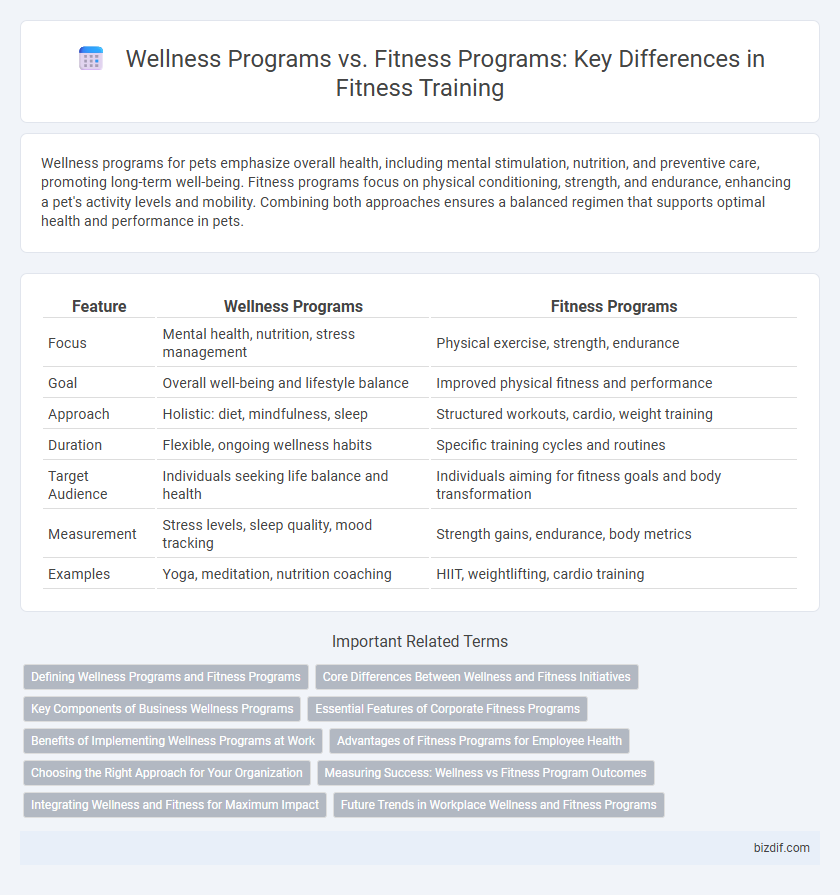Wellness programs for pets emphasize overall health, including mental stimulation, nutrition, and preventive care, promoting long-term well-being. Fitness programs focus on physical conditioning, strength, and endurance, enhancing a pet's activity levels and mobility. Combining both approaches ensures a balanced regimen that supports optimal health and performance in pets.
Table of Comparison
| Feature | Wellness Programs | Fitness Programs |
|---|---|---|
| Focus | Mental health, nutrition, stress management | Physical exercise, strength, endurance |
| Goal | Overall well-being and lifestyle balance | Improved physical fitness and performance |
| Approach | Holistic: diet, mindfulness, sleep | Structured workouts, cardio, weight training |
| Duration | Flexible, ongoing wellness habits | Specific training cycles and routines |
| Target Audience | Individuals seeking life balance and health | Individuals aiming for fitness goals and body transformation |
| Measurement | Stress levels, sleep quality, mood tracking | Strength gains, endurance, body metrics |
| Examples | Yoga, meditation, nutrition coaching | HIIT, weightlifting, cardio training |
Defining Wellness Programs and Fitness Programs
Wellness programs encompass a holistic approach to health, integrating physical fitness, nutrition, mental well-being, and lifestyle management to enhance overall quality of life. Fitness programs primarily focus on structured physical activities and exercise routines aimed at improving strength, endurance, and cardiovascular health. Both programs serve distinct roles, with wellness programs emphasizing preventive healthcare and lifestyle balance, while fitness programs target specific physical performance goals.
Core Differences Between Wellness and Fitness Initiatives
Wellness programs encompass a holistic approach targeting physical, mental, and emotional health through activities like stress management, nutrition counseling, and lifestyle coaching. Fitness programs primarily focus on improving physical performance and body composition via structured exercise routines such as strength training, cardio workouts, and flexibility exercises. Core differences lie in wellness initiatives addressing overall well-being and preventive care, whereas fitness programs concentrate on physical conditioning and athletic goals.
Key Components of Business Wellness Programs
Business wellness programs emphasize preventive health, stress management, and employee engagement, integrating health risk assessments, nutrition counseling, and mental health support. Unlike traditional fitness programs that focus solely on physical exercise, wellness programs incorporate comprehensive strategies including smoking cessation, ergonomic evaluations, and work-life balance initiatives. These key components promote overall employee well-being, reduce healthcare costs, and enhance productivity in the workplace.
Essential Features of Corporate Fitness Programs
Corporate fitness programs prioritize accessibility, personalized workout plans, and progress tracking to enhance employee well-being and productivity. Wellness programs encompass broader health initiatives like nutrition counseling and stress management, while fitness programs focus specifically on physical activity and exercise routines. Essential features include on-site gyms or virtual classes, health assessments, and incentives to promote consistent participation and engagement.
Benefits of Implementing Wellness Programs at Work
Wellness programs at work enhance employee productivity by reducing stress and promoting mental health, leading to lower absenteeism and healthcare costs. These programs foster a culture of well-being that supports long-term lifestyle changes beyond physical fitness alone. Integrating wellness initiatives into the workplace improves employee engagement and creates a healthier, more resilient workforce.
Advantages of Fitness Programs for Employee Health
Fitness programs boost employee health by improving cardiovascular endurance, muscle strength, and flexibility, which reduces absenteeism and healthcare costs. These programs promote consistent physical activity, leading to enhanced mental well-being and increased energy levels throughout the workday. Unlike general wellness programs, fitness programs offer structured exercise routines that deliver measurable improvements in physical fitness and overall productivity.
Choosing the Right Approach for Your Organization
Wellness programs emphasize holistic health, incorporating nutrition, mental health, and preventive care, while fitness programs focus primarily on physical exercise and strength training. Organizations should assess employee needs, workplace culture, and overall health goals to select a program that maximizes engagement and long-term benefits. Data shows integrated wellness approaches often yield higher productivity and reduced healthcare costs, making them ideal for comprehensive employee well-being.
Measuring Success: Wellness vs Fitness Program Outcomes
Wellness programs emphasize holistic health outcomes, including stress reduction, mental well-being, and improved lifestyle habits, while fitness programs primarily focus on physical performance metrics such as strength, endurance, and body composition. Measuring success in wellness programs often involves qualitative assessments like participant satisfaction and behavioral changes, whereas fitness programs rely on quantitative data like VO2 max, BMI reduction, and muscle gain. Integrating both qualitative and quantitative measures provides a comprehensive evaluation of overall program effectiveness.
Integrating Wellness and Fitness for Maximum Impact
Wellness programs emphasize holistic health by incorporating mental, emotional, and physical well-being, while fitness programs primarily target physical exercise and strength building. Integrating wellness and fitness programs creates a synergistic effect that enhances overall health outcomes, reduces stress, and improves adherence to exercise routines. Combining nutrition guidance, mindfulness practices, and tailored fitness plans maximizes impact by addressing comprehensive lifestyle changes essential for sustained wellness.
Future Trends in Workplace Wellness and Fitness Programs
Future trends in workplace wellness and fitness programs emphasize personalized health plans integrating AI-driven analytics to monitor employee progress and tailor interventions. Hybrid models combining virtual fitness sessions with on-site wellness resources foster greater accessibility and engagement. Emphasis on mental health, biometric data integration, and gamification are reshaping employee wellness strategies for improved productivity and reduced healthcare costs.
Wellness Programs vs Fitness Programs Infographic

 bizdif.com
bizdif.com